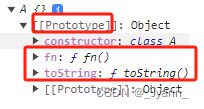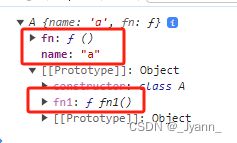ES6 Class和Class继承
1.class的基本语法
class可以理解为是一个语法糖,将js只能通过构造函数创建实例的方法进行了补充
构造函数:
function Person ({ name, age=18 }) {
this.name = name
this.age = age
}
new Person({name: '张三'})Class类:
class Person {
constructor ({ name, age=18 }) {
this.name = name
this.age = age
}
}
new Person({name: '张三'})2.深入了解class的特性
- class的数据类型是一个函数
- class的原型的constructor指向class
- 通过new关键字创建出来的实例的constructor指向class
- class内部的方法是定义在实例的原型上,class内部的属性和constructor里面的方法和属性定义在实例上(构造函数方法定义在实例的原型上,属性定义在实例上 )
- 通过类创建对象的本质是调用类的constructor,如果类未定义constructor,则会在使用时默认添加。
- class不能直接调用,需要通过new关键字(构造函数可以直接调用,也可以new 创建实例)
- class内部方法this指向的是实例,class内部是严格模式(严格模式下不存在变量提升)
- class中箭头函数的this和普通函数的指向不同:class上面定义的普通函数是在实例的原型上;箭头函数this指向定义位置所在的作用域即实例本身,通过解构出来的方法直接调用普通函数的this是undefined,箭头函数是当前实例
- class可以有取值函数(getter)和存值函数(setter)
-
类的属性名可以动态设置
-
静态方法/属性,通过在属性和方法前添加static关键字,静态方法和属性不会被实例继承
-
静态方法里面的this指向的是类而不是实例,所以静态方法里面this === A
-
class定义实例的属性 直接" 属性名=属性值"
1. class的数据类型是一个函数
console.log(typeof class A {})2. class的原型的constructor指向class(类比:构造函数的原型的constructor指向构造函数)
class A {}
console.log(A.prototype.constructor === A)3. 通过 new 关键字创建出的实例的constructor指向该class(类比:new构造函数创建的实例的constructor指向构造函数本身)
class A {}
var a = new A()
console.log(a.constructor === A)4. class内部的方法实际上都是定义在类实例的prototype上;属性定义在实例上;constructor中的方法和实例都定义在原型上
class A {
fn () {}
toString() {}
}
var a = new A()
console.log(a);5. 通过类创建对象的本质是调用类的constructor,如果类未定义constructor,则会在使用时默认添加。
class A {
constructor () {
this.name = 'a';
this.fn = function() {};
}
fn1() {}
}
console.log(new A())6. class不能直接调用,需要通过new关键字(构造函数可以直接调用,也可以new 创建实例)
7. class内部方法this指向的是实例,class内部是严格模式(严格模式下不存在变量提升)
注意方法如果单独使用会报错,class内部是严格模式,所以 this 实际指向的是undefined
普通函数通过实例调用可调用:但是直接结构后调用,普通函数没有找到是谁调用就会报错 。将普通函数改为箭头函数后,箭头函数定义位置在class中,所以this表示当前类的实例的原型
class Logger {
printName(name = 'world') {
console.log(this, 'this')
this.print(`Hello ${name}`)
}
print(text) {
console.log(text)
}
}
// let logger = new Logger();
// // 通过实例调用可以调用
// logger.printName()
let {printName} = new Logger();
printName(); //没有找到谁调用会报错 class Logger {
printName = (name = 'world') => {
// 类中方法的this指向当前class的实例
console.log(this, 'this')
this.print(`Hello ${name}`)
}
print = (text) => {
console.log(text)
}
}
let { printName } = new Logger();
printName(); //没有找到谁调用会报错分析:
- 1.this 实际指向的是undefined,如果想要可以正常调用,可以使用箭头函数(箭头函数的this是由定义位置决定,所以就能获取到this为当前实例)
注意:本身class上面定义的普通函数,是在实例的原型上,但是如果使用的是箭头函数,则当前属性和函数就在类的实例上面了
为什么还能箭头函数中printName还能打印出this?因为箭头函数定义本身没有this,所以它的this的位置指向的是当前实例
- 2.this 实际指向的是undefined,在constructor中对printName进行bind改写this
8.class中箭头函数的this和普通函数的指向不同:class上面定义的普通函数是在实例的原型上;箭头函数this指向定义位置所在的作用域即实例本身,通过解构出来的方法直接调用普通函数的this是undefined,箭头函数是当前实例
class Logger {
printName(name = 'world') {
console.log(this, 'this')
this.print(`Hello ${name}`)
}
print(text) {
console.log(text)
}
}
console.log(new Logger()); class Logger {
printName = (name = 'world') => {
// 类中方法的this指向当前class的实例
console.log(this, 'this')
this.print(`Hello ${name}`)
}
print = (text) => {
console.log(text)
}
}
console.log(new Logger());3.构造函数与class的区别?结合上面的几个特性回答
- class只能通过new关键字调用
- class内部是严格模式(直接解构出方法执行this会返回undefined)
- class里面定义的方法和属性都在实例的原型上,constructor里面定义的属性和方法才在实例上;构造函数方法定义在实例的原型上,属性定义在实例上
- class可以通过static关键字来定义静态方法
4.class的取值函数(getter)和存值函数(setter)
设置后就可以通过实例设置和获取值时触发这两个方法
class A {
get name() {
return '1'
}
set name(value) {
console.log('setter:' + value)
}
}
var a = new A()
console.log(a.name);
a.name = "lmf"5.类的属性名可以动态设置
let methodName = 'test'
class A {
[methodName] () {
console.log("test-----");
}
}
var a = new A()
a.test()6.静态方法/属性
通过在属性和方法前添加static关键字,静态方法和属性不会被实例继承;静态方法和普通方法可以重名
class A {
static fn () {
//静态方法的this指的是类,所以这里this.getValue() === A.getValue()
this.getValue()
console.log(this === A);//true
}
static getValue () {
console.log('张三')
}
getValue() {
console.log('李四')
}
}
var a = new A()
A.getValue()
a.getValue()
A.fn();//静态方法的this指的是类,所以这里this.getValue() === A.getValue()7.静态方法里面的this指向的是类而不是实例
8.定义实例的属性
class A {
a = 1
b = 'SUCCESS'
}9. 类的继承
- 类的继承通过extends关键字
- 子类中的constructor不写时会隐式生成一个constructor函数,如果显示写了constructor则必须调用super,否则就会报错。
- 子类调用super会触发父类的constructor并将参数传递过去
- 在super调用前子类是没有this,如果使用会报错
- 类在继承时属性会被直接添加到实例中,方法则保留在类的原型上(跟类本身属性和方法的位置一样,类本身方法在原型上,属性在实例上,constructor中的方法和属性在实例上)
class F {
constructor (sMoney) {
this.money = 100 + sMoney
}
fn () {}
}
//通过extends实现继承
class S extends F{
//子类中显示调用constructor时必须同时调用super()方法
constructor (money) {
// 在super调用前子类是没有this,如果使用会报错
//子类调用super(money)会触发父类的constructor并将参数传过去
super(money)
}
}
console.log(new S(10))
// 类在继承时属性会被直接添加到实例中,方法则保留在类的原型上
console.log(S.prototype.__proto__ === F.prototype); //true


